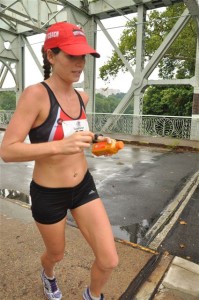The long run. Often intimidating. Rarely easy. It’s the keystone to training for a marathon or half marathon. It’s also the run most folks training get wrong. Here are some things you can do to better your long run, your overall training, and the reasons why you should handle your long runs certain ways.
- Think of your long runs as dress rehearsals for race day. This means you should practice eating dinner and breakfast the way you would before your race. it also means you should plan mid-run fueling as you would for race day. If you decide to “wing it” on race day, you are foolish. You have weekly long runs between now and race day. Use them as practice.
- Don’t be scared of bombing a long run. If something goes wrong, LEARN from it. Perhaps you will need to cut the run short due to dehydration, chafing, or take a detour or a bathroom break. Or perhaps you need a walking/stretching break. Or you lose your mental focus and cannot get it back. IT’S OKAY. Figure out why these things are happening, and then we can fix them and never make those mistakes again. A bad long run isn’t a bad thing if you can learn from it.
- Test out your fueling options. Some folks can take any kind of nutrition on the run and feel great. Other’s find almost every endurance fuel out there leads them to racing for the bathroom. There are dozens of fueling options. Find what feels best for you. Do you love caffeine GU? Do you need to avoid caffeine at all cost? Do you love your nutrition in liquid-form like Gatorade? What kind of Gatorade? Again, the long runs are rehearsals.
- Take your pace easier than race day on your long runs. This is a hard concept for many runners planning for a marathon. The logic is often that you want to run at marathon goal pace so you know you can. Let go of that ideal. In fact, plan to run most long runs at marathon goal pace PLUS :15-45 seconds PER MILE. Why? Well here’s the short answer: to reduce injury risk. Think about it – when you finally run your 26.2 mile journey, it will be after a taper and you will plan to take at least a week off from running post-marathon. So HOW can you expect to run a 20-miler at your marathon pace and be recovered to run your speed workout a few days later? You cannot. Well you can, but your risk of injury is stupid high. Plus, if you are running speed workouts, running a “fast” long run has no real benefit. If you are sticking to a plan that includes speed workout and easy long runs, the combination will have you prepared for marathon day. I swear. I have yet to meet a coach who recommends you run your long runs at your goal race pace.
- There are a few times when progressive long runs are beneficial. These should be handled with caution and are only ideal for experienced marathoners. Progressive long runs can vary in formula, but always end with finishing the long run faster than you started. Some will end with the runner finishing the final miles at marathon goal pace. Again, only for the experienced marathoner and with the advice of a coach.
- Long runs are about time on your feet more than pace.
- Regardless of pace, cap long runs at 2:30-3 hours. Reason being, injury risk goes up as the hours pile up. Again, totally understandable that a runner aiming for a 4 hour marathon wants to clock long runs of 4 hours, but hang in there. Instead, cap long runs at 2:30-3 hours and perhaps go for a second run within the weekend, perhaps within 24-36 hours – giving your legs the experience of running on tired legs but with the benefit of some recovery.
- Long runs also give you the opportunity to practice recovery. Take the opportunity to figure out how you feel, what you need to eat and drink, and how your body reacts to the stress of the long run. Some runners are nauseous for hours post-run, while other runners want to eat everything in sight. Some runners have a hard time stretching, foam rolling and taking care of themselves, others are on it like rock stars. We can always make improvements, so budget time to handle yourself as needed after you clock that big run.
- The long run is also a rehearsal for what to wear on race day. While seasons may change in the course of your training, try to wear what you may want to race in for some of those final long runs. Weather should be pretty accurate, as should your size and how clothes will fit you. Take note of any problem areas with chafing, and if you simply feel good or bad in what you wear.
- If the long run is mentally intimidating, break it up into smaller sections. Taking on a 20-miler can seem like the worst thing ever, but 4 5-milers, refueling with GU every 5 miles suddenly doesn’t sound so hard. Remember that some miles will feel better than others, and often those middle miles are the hardest to grind through. Once you see mile 17 of 20, the light at the end of the tunnel is in sight.
Lastly, be sure to write down or remember what worked and what didn’t. That information can be priceless. How long did you eat before your run? Were you hydrated enough? How much sleep did you get? What fuel did you use and what was the outcome? Do you love or hate a certain training route? Were there mental roadblocks and what tricks got you past them? These are all clues that can lead you towards a successful marathon.





